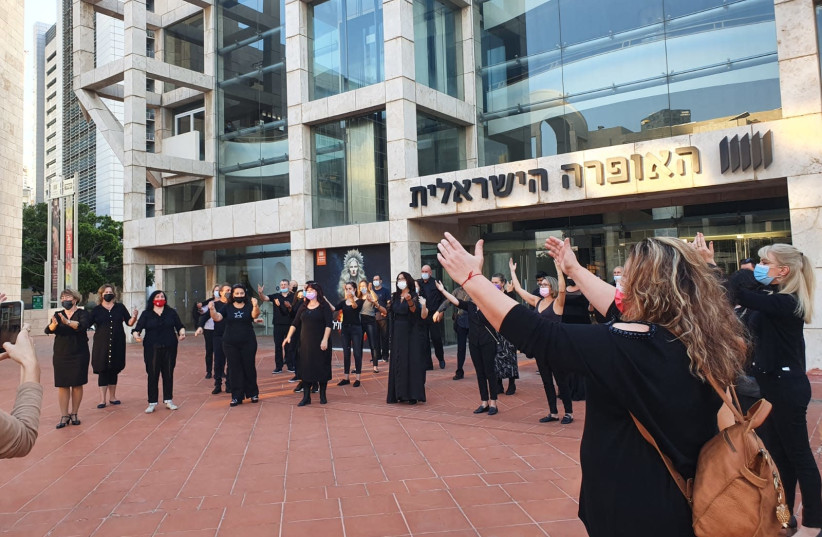Red light spills on a man undressing during the opening scene of Mozart’s Requiem, shown at the Israeli Opera. In a loincloth, he dances gracefully across the stage. Behind him, the choir, its members fully dressed, beseeches divinity to grant rest to the soul of the departed. They offer to appease the wrath of heaven with a vow to be given in Jerusalem.
Costume designer Ula Shevtsov imagines the mourning rites of the stage world performed by humans wearing white garments. These are a hybrid of the clothes worn by the Temple Priests of Judea and of those of the North African Tuareg.
The people touch their wrists and heads in what could be a ritual cleansing of their garments from the impurity of death. They present their skirts; unlike the dead man they are covered in cloth, ergo, they are still living. The near-naked dancer lays in state as former friends and lovers heap bright golden shawls on his resting place.
“The trumpet will spread its sound to all the graves” the choir sings. Grand arches descend on the stage, offering the illusion of a never-ending tunnel, deep in the bowels of the earth. “Death and nature will stand amazed,” they declare.
Then, a female figure appears. She is offered a seat, her head adorned with ointments. She is given the golden shawls to hold. A gleaming ball of light flickers behind her. People dance and throw confetti as they lauded the “King of awful majesty.” They remind him qui salvandos salvas gratis (“you freely save those worthy of salvation”).

The scene is powerful and striking. Its theological power is manifest. God is indeed a free being, and to accept God’s ability to be, one would have to accept the notion that salvation is gratis. One cannot hope to win it by feeding the hungry, any more than one can aspire to it by buying a papal indulgence.
The contrast between the confetti and the dimming light of the mechanical sun brings the majesty of this concept home. Humanity can ask for salvation, yet its very nature makes obtaining it uncertain.
The artificial orb dims as divine voices sing cor contritum quasi cinis (“heart as contrite as ashes”). Then the whole thing starts up again. Another dancer stands, bathed in red light. He undresses and dances in abandoned freedom across the stage, as his discarded clothes are his chains to the world, to society, and to morality. Again his peers cover him in gold shawls.
At several points, the members of the mini-society on stage sweep up the confetti and open black garbage bags to dispose of the mess, just as family members do after a shiva.
Director succeeds in her objectives
Director Shirit Lee Weiss and lighting designer Nadav Barnea are wonderfully successful in the goal they set for themselves. They offer an alienated, yet eerily beautiful, insight into mourning rituals.
Mozart’s music is a different matter. Divided into 12 textual portions, the themes return, but the music, like life, always advances in time. Under conductor Karl-Heinz Steffans the performance was impeccable.
Yet, perhaps unavoidably, the unusual, almost anthropological visuals of this performance confused the audience. Some patrons began clapping at a certain moment, then realized their mistake when the scene and music continued and sheepishly stopped.
When a third dancer began to shed his clothes a man who sat next to me groaned: “Again?”
The late conductor Nikolaus Harnoncourt suggested how, in his opinion, we misread Mozart: “When people go to a concert in order to enjoy “Mozartian bliss,” and perhaps discover “Mozartian truth,” he wrote sharply, “it might well upset them, for they may have no desire whatsoever to hear “Mozartian truth.”
What happens then, when to this unrealized allure of Mozartian bliss, one adds a highly estheticized and alienated mourning practice?
The performance is a visually stunning creative tour de force. One hopes that the exciting visual dimension – rare for Requiem – appeals to a younger generation of curious music lovers, becoming a gateway into the operatic universe.
Mozart’s Requiem will be shown Sunday, July 23, at 6 p.m. and 9 p.m. Tickets from NIS 125-NIS 375. Latin with Hebrew and English subtitles. Call (03) 692777 for bookings. The Israeli Opera, 19 Shaul Hamelech St., Tel Aviv.
